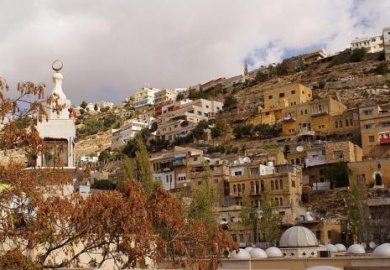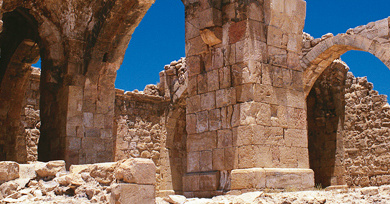MOUNT NEBO
Drive along the same route prophet Moses (pbuh) was forbidden to travel on by the King of Edom (Numbers 20), and picture yourself standing where Moses was laid to rest, and where the late Pope John Paul II tread on his first pilgrimage of the millennium.
Visit the Sanctuary at Nebo: the memorial of Moses (pbuh), the presumed site of his death and burial place, and a center for pilgrimages since earliest Christian times. You’ll be inspired by the biblical feel from start to finish as you experience this divine tour.
Mount Nebo is one of the most revered holy sites of Jordan, located 10 km (6 miles) west of the Roman Byzantine town of Madaba, for this is where Moses (pbuh) was buried. The site’s association with the last days of Moses is described in moving words in Deuteromony (34:1-7). The episode of Balak and Balam (2:13-26) also took place here.
The site’s other name is Pisgah: “And Moses went up from the plains of Moab to Mount Nebo, to the top of Pisgah which is opposite Jericho”. From the mountaintop, which is the highest point in the Moabite range, rising to about 800 meters at its apex, you can admire the dazzling view across the Jordan Valley and the Dead Sea, to the rooftops of Jerusalem and Bethlehem.
Centuries ago, pilgrims flocked to Mount Nebo on their final destination to visit the sanctuary. These pilgrims left behind vivid accounts of their travels, which helped archaeologists identify this sanctuary.
In the summer of 1933, excavations at Syagha, one of the highest peaks at Nebo, began under the direction of the Jerusalemite Franciscan Fathers. Three long archaeological campaigns had previously resulted in the discovery of the Basilica and of a large monastery, which had continued to expand through the 6th century.
Mount Nebo’s first church was constructed in the 2nd half of the 4th century to commemorate the place of Moses’ death. It had three apses and was preceded by a vestibule paved with plain white mosaic; two funeral chapels stood to the north and south of the lateral apses.
Six tombs have been found hollowed from the natural rock beneath the mosaic-covered floor of the church. In the present presbytery you can see remnants of mosaic floors from different periods. The earliest of these is a panel with a braided cross presently placed on the east end of the south wall.
The Old Diaconicon Baptistery
The three apsed cella (cella trichola) was preceded by a courtyard. In August 531 AD a Diaconicon Baptistery was built to the north of the courtyard against one of the funeral chapels. It was reached by a short flight of stairs, as it was one meter lower than the floor of the courtyard.
This rectangular room contained the baptismal stone fountain fashioned in the form of a cross and coated with a thick layer of time plaster. Two Greek inscriptions show the date of the mosaic floor (August 531), the name of the mosaicists, Soel, Kaium, and Elias, and the name of the Bishop of Madaba, Elias.
In its decorative scheme, the mosaic floor is divided into three distinct panels in floor registers depicting pastoral and hunting scenes.
The 5th-7th Century Basilica
In the latter half of the 6th century the monks decided to enlarge their sanctuary. When removing the facade, the primitive church became the presbytery and the three naves were constructed on the site of the old vestibule and courtyard.
The mosaic work decorating the new basilica was integrated into a single large design or composition centered on a grapevine, with a swastika motif running along the perimeter of the interior of the building. Of this large composition, all that remains today are some geometric designs from the two lateral naves, a large section of the panels that adorned the intervals between the columns, and two fragments from the central nave.
The New Diaconicon
After the funeral chapel and the Diaconicon Baptistery were dismantled, the floor was adjusted to level with the rest of the basilica, making a single large chapel divided by stairs and railing into two separate rooms. The eastern room was decorated with mosaic depicting animals and flowers inserted in a geometrical frame; the western room was graced with geometrical motifs.
The elongated chapel might have been used as the Diaconicon of the basilica and as a chapter room for the monks.
Perhaps during the same period in which the Diaconicon was altered and embellished, the ancient funeral chapel was destroyed, and a new room, replete with mosaics, was built instead. This was replaced by a new baptistery with its own mosaics in 597-598 AD. Over the threshold at the entrance of the baptistery, was a welcoming inscription, “Peace to All”, placed to greet visitors entering the chapel.
The Theotokos Chapel
During the first decade of the 7th century, the western door to the baptistery was walled up, three rooms of the monastery were destroyed, and the floor was leveled with the rest of the basilica. This provided the basis and foundation for the construction of the Theotokos (Mother of God) chapel.
This chapel had its own apse and was divided by a railing into two distinct rooms. The floor decoration received special attention with rich geometric multi-color designs encompassing pictures of flowers, animals as well as a ciborium above an altar flanked by two bulls and gazelles.
While the sanctuary was undergoing various stages of architectural development, a parallel series of improvements and changes were taking place in the adjacent monastery. From its primitive nucleus of cells discovered by the archaeologists just outside the basilica on the northern side of the mountain, the complex gradually expanded into a monastic community of a respectable size in that very monastic Byzantine world.
The restoration work preserved for future generations this extraordinary Monument of the Faith and brought new life to a sanctuary constructed in ancient times to honor Moses, the Prophet and man of God. Since September 4, 1976, the annual feast of Moses is celebrated and the Christian community join with the Franciscan Fathers in this solemnity.
The Italian artist, Giovanni Fantoni, is credited with designing the metal decorations inside the sanctuary as well as the Serpentine Cross (The Brazen Serpent Monument) on the exterior. These are symbolic of the bronze serpent taken by Moses (pbuh) into the desert, and the cross upon which Jesus (pbuh) was crucified.
About 1 km east of Mount Nebo, you can see the spring of Moses, mentioned by Egeria, Peter the Iberian, and Theodosius. In the springtime, this area is dotted by Eucalyptus trees, which grow close to two churches built in the 6th century, with enchanting mosaics: the churches of Deacon Thomas and Kayanos which were adorned with another mosaic pavement in the 7th Century. The churches were destroyed by a powerful earthquake which hit the region in AD 749.




Facebook Comments